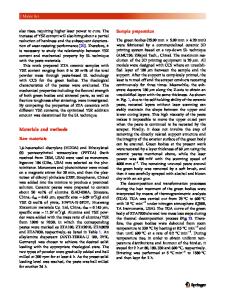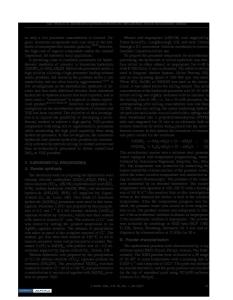Improvement in mechanical properties of sintered zirconia (3% yttria stabilized) by glass infiltration
- PDF / 304,509 Bytes
- 8 Pages / 585 x 783 pts Page_size
- 13 Downloads / 324 Views
B.B. Panigrahia) and Min-Cheol Chu Division of Advanced Technology, Korea Research Institute of Standards and Science, Yuseong, Daejeon, 305-340, Republic of Korea
T.N. Kim Department of Information and Electronic Materials Engineering, Paichai University, Daejeon, 302-735, Republic of Korea
Kyung-Jin Yoon and Seong-Jai Chob) Division of Advanced Technology, Korea Research Institute of Standards and Science, Yuseong, Daejeon, 305-340, Republic of Korea (Received 13 January 2007; accepted 8 May 2007)
The goal of this work was to improve the strength of sintered zirconia (3 mol% yttria stabilized) by surface treatment, using a low expansion glass (Mg3Al2Si6O18) at high temperature. The room-temperature strength was increased by about 42% when the glass was penetrated for 30 min. There was a drastic increase in the Weibull modulus. However, the longer holding time led to grain coarsening and the excess glass deteriorated the strength. The magnitude of the strength increment was on the order of surface stress measured experimentally and thermo-elastic stress predicted theoretically. A significant contribution of phase transformation of zirconia from tetragonal to monoclinic phase on the residual stress was also found. Furthermore, compared to the as-sintered zirconia, the glass-treated sample (penetrated for 30 min) exhibited relatively higher strength at elevated temperature (750 °C) and also showed a significant improvement in the thermal shock resistance behavior.
I. INTRODUCTION
The strength of polycrystalline ceramics is enhanced by inducing compressive stresses on the surface by thermal treatments and quenching.1,2 The compression in the surface region can be introduced by incorporating a secondary phase of lower thermal expansion property at a high temperature. Alumina has been strengthened by introducing Cr2O33 and mullite4 on the surface by solid solution diffusion during annealing. To strengthen the ceramics, the compression should be introduced down to the depth of strength-controlling flaws (typically on the order of 50 to 200 m). However, to obtain a deep compression zone, the diffusion based process requires a longer annealing time, which coarsens the microstructure. Several other techniques are used to increase the
Address all correspondence to these authors. a) e-mail: [email protected] b) e-mail: [email protected] DOI: 10.1557/JMR.2007.0325 2550 J. Mater. Res., Vol. 22, No. 9, Sep 2007 http://journals.cambridge.org Downloaded: 20 Mar 2015
strength of alumina such as coating of silica on the surface by the sol-gel method5 and reacting the powder compact with N2 and Mg vapors to form additional compounds such as AlN, MgO, and MgAl2O4 on the surface.6 Improvements in the mechanical properties of the ceramics by surface glass infiltration have been achieved.7–11 The flexural strengths have been increased by about 53% in alumina9 and by about 55% in zirconia toughened alumina10 by the glass infiltration method. It is clear that the glass penetration helps in healing the flaws. The nature of stre
Data Loading...











